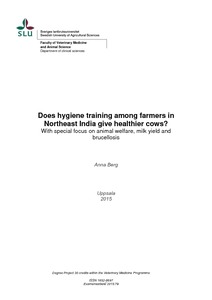Does hygiene training among farmers in Northeast India give healthier cows? With special focus on animal welfare, milk yield and brucellosis
Abstract
In the years of 2009-2013 a hygiene training program was developed in the north eastern state of Assam, India, by the International Livestock Research Institute (ILRI) together with local partners. The goal was to improve the hygiene and quality throughout the process of producing and selling milk. This study aimed to follow up the training and to critically evaluate the impact the training had on the overall health and welfare of the animals as well as the milk production. Seroprevalence of brucellosis in the area was also investigated. The study was carried out as a Minor Field Study financed by the Swedish international development cooperation agency (SIDA). A comparison was made between 74 farms where the farmer previously had engaged in hygiene training (“trained farm”) and 76 farms where nobody had been trained (“non-trained farm”) regarding overall health status, hygiene routines and seroprevalence of brucellosis. Clinical examinations were used to check body condition, hygiene status and hoof status of the cows. Milk sampling took place to investigate milk seroprevalence of brucellosis, using the Brucella milk ring test (MRT) and a questionnaire was used to interview farmers about hygiene routines, health status, milk yield etc. The results showed that the ILRI hygiene training had positive effects in some areas and foremost was associated with a significant increase in the milk yield (p=0.003), with a mean increase of 0.67 liters of milk per cow per day in trained farms. Because milk production is the main income for 90% of the farmers, this increase should have a large impact on their economy. No difference was seen between trained and non-trained farms regarding body condition, hygiene and hoof status. However, a majority of the trained farmers had experienced an improvement in the overall health status of the animals.
The MRT showed that at least half of the tested cows in Assam were positive for brucellosis. No difference was seen between trained and non-trained farmers which was not surprising since the hygiene training did not focus on disease control. Six areas were visited and significant differences were seen in seroprevalence with the area of 8th Mile having the most brucellosis and Amsing Jorabat having the least. One important factor in the spreading of brucellosis is through infected semen, and it is recommended that routines for breeding are studied further. Increasing the general knowledge about the ways of infection is important in trying to limit the spread of the disease, especially in a country like India where slaughter of cows is prohibited.
The conclusions of the study were that hygiene training is associated with a positive effect in milk yield thus having an important impact in improving the economy of the farmers. It also seems to have improved the over-all health status among dairy cows based on experience of the farmers.

